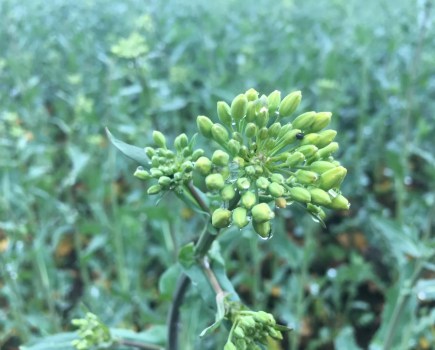Investing in biostimulants has helped one Hants farmer to continue to include oilseed rape in his rotation, despite a tricky few years. Charlotte Cunningham reports.
Establishing oilseed rape is not easy. Growers are often faced with the dilemma of whether to continue to invest in a crop or cut their losses and abandon it. This was the stark decision facing Al Brooks, estate director of Faccombe Estates in North Hampshire last year, when, as a final throw of the dice he applied the biostimulants Bridgeway/Zonda, to his drought-stricken crop.
This single application of biostimulants not only gave him a viable crop to go into the winter, it was also responsible for one field growing on to yield over 5 t/ha.
Al said: “The cropped area on the estate is divided in two and is walked by Steve Cook from Hampshire Arable Systems and Andrew Richards from Agrii. Last year oilseed rape establishment was definitely not ideal, it was so variable and slow that I had to be persuaded by my agronomists not to spray it out and start again. Thankfully I didn’t, because a single application of Bridgeway on one part of the farm and sister product Zonda on the other, transformed the crop, with an average yield of 4.4 t/ha and one stand out field yielding 5.1 t/ha.”
That field had been established conventionally using a Vaderstad drill on the 31 Aug and sown with Rocca, a high erucic acid rape (HEAR), at a rate of 3kg/ha with a seed bed application of starter fertiliser.
“The soil conditions and the prevailing weather at the time were exceptionally dry which resulted in uneven and sporadic germination,” he added. “Fortunately, we had really low levels of cabbage stem flea beetles, (CSFB), however, we were still looking at a plant population of only 35 plants/m2, nowhere near our ideal population of 60 plants/m2, so I was worried.
After a discussion with Emma Ralph, managing director of Interagro, about adjuvant and biostimulant technology it became apparent there were a number of innovative biostimulant products in Interagro’s portfolio and as such it became clear that Bridgeway and Zonda were the products to use.”
Final straw
Al applied 2l/ha of Bridgeway/Zonda across all the oilseed rape area on the 12 Oct. “That,” he says, “Was the final thing I was prepared to do for the crop.”
Within a fortnight of the application of Bridgeway/Zonda both Al and assistant manager, James Higginbotham, could see that the crop had been transformed.
“The well-established plants which were only at 4 leaves, took on an all together different colour, becoming much greener,” added Al. “The smaller plants which had been looking particularly stressed started going through the growth stages very quickly and when you looked at the plants it was all about the root development.
The roots grew longer, there were more hairs on the roots, and we got an altogether more fibrous root system. It became a very different crop, and as soon as we did get some moisture, we had roots there to take it up. The crop just went from strength to strength, with the shoots growing away once the roots had established.”
Independent research
Stuart Sutherland, Interagro technical manager said: “We have recently been working with the University of Nottingham to research the impact of our biostimulant Bridgeway/Zonda on plant health. This independent research has shown that Bridgeway/Zonda significantly increases root and corresponding shoot growth in oilseed rape. Using Bridgeway/Zonda at 2l/ha, from the 2-leaf stage, as Al did, increased rooting by 112% over the untreated and this increased rooting led to corresponding increases in shoot growth of 43% over the untreated.”
These statistically significant findings show how Bridgeway/Zonda promotes faster establishment, he added. “The increased root and shoot growth, even whilst under environmental stress, enables plants to better tolerate their exposure to stress and because Bridgeway/Zonda supplies all the amino acids and peptides a plant needs, metabolic and photosynthetic efficiency is also enhanced resulting in more growth, which gives the potential to grow away from problems.”
Oilseed rape is an important part of the rotation at Faccombe Estates both financially and culturally as soil type and topography limit the type of break crops which can be grown.
“Although the plant population was low, the application of Bridgeway/Zonda ensured it was maintained. We only grow HEAR and the contract terms that we have make it more profitable than growing conventional rape,” added Al.
Significant premium
Chris Spedding, commercial director of Premium Crops, who Al grows his HEAR for, said: “HEAR crops receive a significant premium, increasing the gross margin by between £90- 140/ha. If Al’s crop had failed, he would have had the double blow of losing a very profitable break crop and the money spent establishing it. For us too, obviously there are consequences, as we have no crop to market, which is a big problem.
In terms of risk management, anything that gets the crop moving fast at establishment is beneficial and has got to be something that we take very seriously in order to attempt to reduce the high rates of early crop failure.”
Stuart agreed: “A rapid start in good growing conditions is the best environment for an oilseed rape crop that goes on to yield over 5 t/ha. Using Bridgeway or Zonda, from two true leaves can be a useful insurance to promote plant establishment in the autumn, when conditions, as Al has experienced, are rarely ideal.”
This year the HEAR on Faccombe Estates was sown into good moist seedbeds and has established well, with as yet, no issues with CSFB.
Al added: “We will be using Bridgeway/Zonda across the board again. Because this is in effect a better year, there will be an opportunity to capitalise on products which we already know works: Bridgeway/Zonda.”




